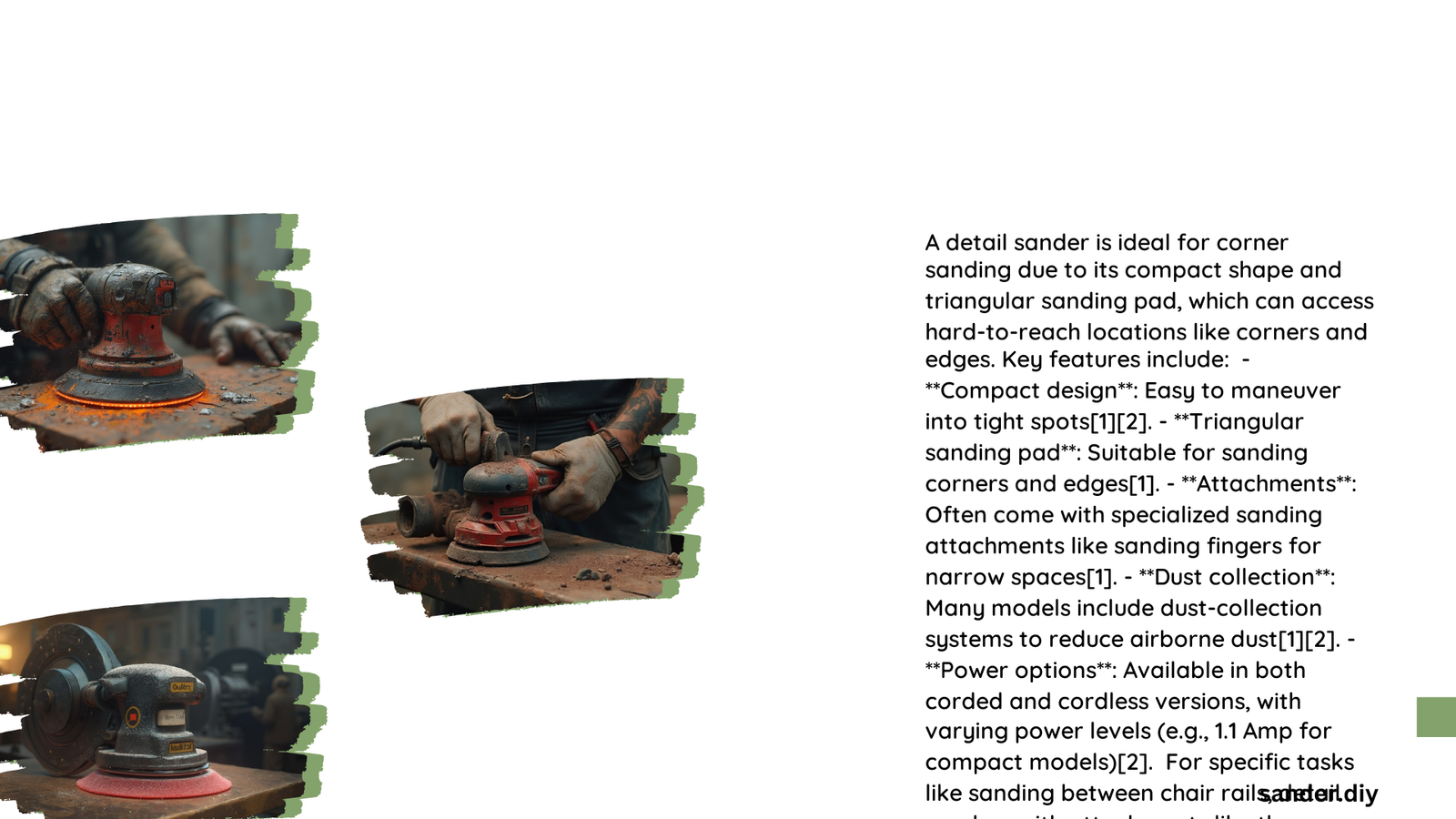Detail sander corners are specialized tools designed for precision sanding in tight spaces, corners, and edges. These tools feature triangular or pointed sanding pads that allow users to reach difficult areas with ease. Detail sander corners are essential for woodworking, furniture restoration, and fine finishing tasks where standard sanders cannot access. They offer improved control and accuracy for achieving smooth surfaces in confined spaces.
What are the Dimensions and Grit Types of Detail Sander Corner Pads?
Detail sander corner pads come in various dimensions and grit types to suit different applications:
- Bosch Detail Sanding Triangles:
- Dimensions: 3.75 inches
- Grits: 40, 60, 80, 120, 180, 240
-
Some models feature 6 perforations for dust extraction
-
Diablo CAT/Mouse Detail Sanding Sheets:
- Dimensions: 3-7/8 in. x 5-1/2 in.
- Available in multiple grits, including 220
-
Hook and lock backing for easy attachment
-
RYOBI Corner Cat Sand Paper Assortment:
- Dimensions: 5-1/2 in.
- Hook and loop backing
- Specifically designed for corner profiles
Performance on Different Materials
| Material | Recommended Grit Range | Notes |
|---|---|---|
| Softwood | 80-220 | Start with lower grit for rough surfaces |
| Hardwood | 100-240 | Higher grits for fine finishing |
| Plywood | 120-180 | Avoid over-sanding to prevent damage to thin veneer |
| Metal | 120-400 | Use finer grits for polishing |
| Plastic | 180-400 | Very fine grits to prevent scratching |
Which is the Best Detail Sander for Corners?

One of the top-rated detail sanders for corners is the SKIL Corded Detail Sander SR250801. Here are its key features:
- Power: 1A motor (approximately 120 watts)
- Weight: 1.77 pounds
- Speed: 12,000 orbits per minute (OPM)
- Vibration Control: Features a counterweight balance for reduced vibration
- Dust Collection: Includes a dust box for cleaner operation
This sander is particularly effective for fine finishing in large surfaces and corners/edges, making it an excellent choice for detail sander corner applications.
What Detail Sander Corner Attachments are Available?
Several detail sander corner attachments are available in the market:
- Bosch Detail Sanding Triangles:
- Compatible with oscillating multi-tools and detail sanders
- 3.75-inch triangular shape
-
Available in various grits and pack sizes
-
Diablo CAT/Mouse Detail Sanding Sheets:
- 3-7/8 in. x 5-1/2 in. sheets
- Hook and lock backing system
-
Suitable for mouse sanders and similar tools
-
RYOBI Corner Cat Sand Paper Assortment:
- 5-1/2 in. corner cat sandpaper pads
- Hook and loop backing
- Designed specifically for RYOBI corner sanders
When choosing attachments, ensure compatibility with your specific sander model and consider the material you’ll be working on to select the appropriate grit.
How to Use Detail Sander Corner Effectively?
Follow these steps for effective use of a detail sander corner:
- Prepare the Surface:
- Clean the area to be sanded
-
Remove any loose debris or old finish
-
Select the Appropriate Grit:
- Coarse (40-60): For heavy material removal
- Medium (80-120): General sanding and smoothing
-
Fine (150-220+): For finishing and polishing
-
Attach the Sanding Pad:
-
Ensure the pad is securely fastened to the sander
-
Start Sanding:
- Begin with light pressure
- Move the sander in small, overlapping circles
-
Work in multiple directions for even sanding
-
Progress Through Grits:
- Start with coarser grits and progress to finer ones
-
Clean the surface between grit changes
-
Check Your Work:
- Regularly inspect the surface for evenness
-
Feel for smooth transitions, especially in corners
-
Finish and Clean:
- Use the finest grit for a smooth finish
- Clean the surface thoroughly after sanding
Tips for Better Results:
- Maintain a consistent speed (around 12,000 OPM for most detail sanders)
- Use light to moderate pressure to avoid damaging the surface
- Keep the sander moving to prevent creating divots or uneven areas
- Utilize dust collection systems to maintain a clean work environment
What are Common Challenges with Detail Sander Corners?
- Maintaining Even Pressure:
-
Solution: Practice consistent, light pressure and frequent visual checks
-
Accessing Tight Corners:
-
Solution: Use the pointed tip of the sander and consider smaller attachments if necessary
-
Avoiding Over-Sanding:
-
Solution: Start with higher grits and progress slowly, checking frequently
-
Managing Dust:
-
Solution: Use a dust collection system or vacuum attachment
-
Preventing Swirl Marks:
- Solution: Use finer grits for finishing and move the sander in multiple directions
By addressing these challenges and following the recommended techniques, you can achieve professional-quality results with your detail sander corner.
